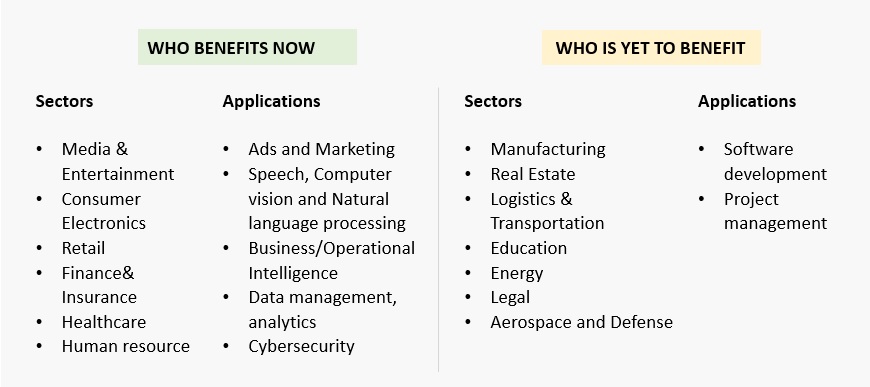AI and ML: Sectors that already benefitted and sectors yet to benefit

Marmore Team
02 April 2020
Artificial intelligence (AI) has been around for decades, but the technology today gains prominence with the enormous availability of data and the increasing computational speed. AI is a broader concept that encompasses multiple tools and can be defined as a constellation of technologies, from machine learning to natural language processing that allows machines to sense, comprehend, act and learn (Accenture). The present promising AI products like self-driving vehicles, digital assistance from SIRI to CORTANA are some of the results of evolved research in the field of AI and Machine learning techniques. Big tech companies are not just focusing on increasing productivity and operational efficiencies with AI but also centers on adding AI capabilities to their products, making them more sophisticated. Over the last few decades, huge progress has been made in AI spaces like pattern recognition, machine translation, image recognition and so on. Additionally, Machine Learning algorithms that learn from data, unlike any rule-based programming, are now made more advanced. Automation of routine, repetitive tasks and automation of the decision-making process without human intervention are some of the key endeavours that AI promises to deliver.
A broader proposition is that AI will markedly stimulate economic growth, improve productivity and likely improve the quality of life. However, it appears that much of the potential AI applications have been vaunted. Even with such clear postulations that AI can potentially enhance businesses and improve productivity, businesses and public organizations are taking a guarded approach in deploying AI on their business functions. There are critical technical challenges that likely impedes its practical applications, and this largely surrounds the data used for analysis. As AI is only as good as the data we provide, data becomes a critical component in the AI/ML applications. The algorithms require vast data sets to identify the trends, patterns, to predict and produce the desired outcome.
AI and ML models thrive on huge volumes of data, thus, AI applications in entirety depend on quality data. The data has to be trained to do the clearly defined task; a well-trained data model is a key component for its large scale adoption. Machine learning models require access to accurate/complete data, therefore, availability of qualitative reliable data becomes a critical need for the performance of these learning algorithms. Poor data inputs can skew results and could lead to systemic risks, for instance, the October flash-crash of the pound-sterling was likely due to an overzealous trading algorithm, which dropped the currency by almost 10 percent (KPMG). Bias in AI systems is another key challenge that could affect the decision making process. There are number of ongoing researches and discussions to address AI biases that could be detrimental to society and businesses. In addition, most of the machine learning algorithms lack interpretation hence does not provide the reasoning or the criteria used for its predicted outcomes.
Essentially, there is an evident gap between the AI/ML in theory and those in practical implementation. While there are a number of caveats in realizing the full potential of AI/ML technologies, AI/ML techniques are widely implemented in companies/businesses that find its clear applications; those include sectors like media and entertainment, e-commerce, healthcare, and financial services. Within these sectors, AI has primarily benefitted in functions like providing recommendations, marketing and digital assistance, predominantly using its predictive capabilities.
Exhibit 1: Indicative List of Sectors/Industries that Capitalize on AI
In understanding the gap between the concept and practice, it is also necessary to weigh other wide-ranging factors that could encumber the practical adoption of AI/ML models. For instance, regulations will play a significant role in setting the platform for AI adoption and growth. To enact AI at large scale, regulators and policymakers should establish a clear strategy that enables the transition for such a technological future. For AI to be successful in a large industrial context, open data and data sharing might become a prerequisite. However, the regulations/policies in this space are yet to be standardized, the pace of the regulatory response does not match with the pace of these technological developments; when new regulations on data security, privacy are in place there could be real world barriers for AI deployment.
Similarly, AI applications, when integrated with businesses and industries, are expected to increase productivity and efficiency; however, these entities lack the necessary enabling infrastructure. Additionally, AI design and adoption incurs high resource costs. With these, lack of AI expertise and subject matter experts presents other challenges to leverage the maximal potential of AI.
While research in AI and machine learning techniques is a multi-decade journey, most organizations have a long way to go in unleashing its application in practice. The last few decades have seen remarkable growth in AI/ML research; however, organizations have been slow in AI adoption and have not capitalized with these techniques yet. The technology is far less likely to be considered advanced at this stage, hence could be unreliable in deploying across critical sectors like healthcare and law. However, research and investment in AI is accelerating as various industries/sector look to embrace innovation, increase competitiveness and efficiency. With the proactive research agenda across entities, the AI/ML space will likely see maturity. The ongoing research and developments could develop solutions that might far outweigh its downsides and reduce the gulf between theory and practice.
Related Articles:
Stay Tuned To Marmore MENA Insights!
Never miss a patch or an update with Marmore's Newsletter. Subscribe now!
Related Article
The Dynamic Rise of Fintech in the GCC
The convergence of technology and finance is reshaping the GCC Financial Ecosystem. The blog explores key players, regulatory framework and market dynamics of Fintech in the GCC region.
Read MoreHow secure are GCC banks compared to their global counterparts?
The blog examines the impact of cyber attacks on financial institutions and the resiliency of GCC banks compared to their global counterparts
Read More2024 Kuwait Banking: Interest Rates and NIM Trend Analysis
The blog discusses how net interest margin of Kuwaits banks has moved across interest rate cycles, in light of awaited policy rate cuts.
Read More




